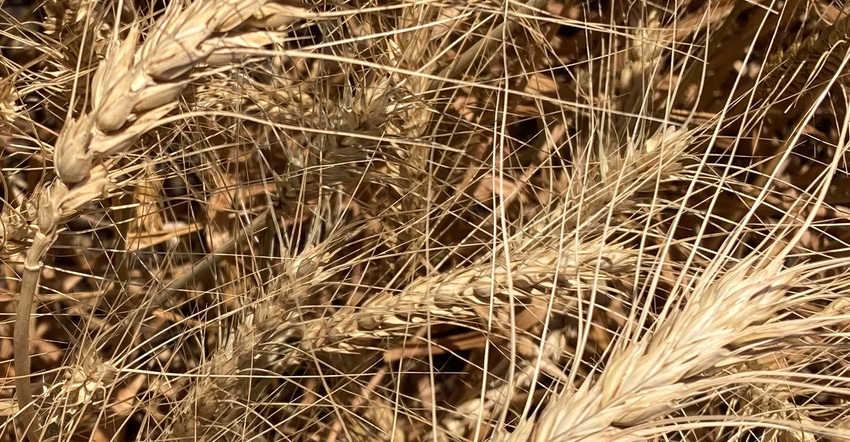August 31, 2021

Just like Kansas producers, the Kansas State University wheat research team has to battle Mother Nature in its testing plots every year. It’s that real-world testing that proves the breeding decisions.
The team announced recently it will advance two breeding lines to seed production ahead of potential variety releases in 2022. The potential wheat varieties result from the long-running breeding program at the K-State Agricultural Research Center at Hays, led by Guorong Zhang, a Kansas State University associate professor and wheat breeder, and his team. The program — supported financially by Kansas wheat producers through the Kansas Wheat Commission — focuses on the development of new and improved varieties of both hard red winter and hard white winter wheat for western Kansas.
“Our goals in the breeding program are to develop new wheat varieties that give Kansas producers top agronomic performance, and provide protection from major pests and diseases,” Zhang says. “It is imperative that the varieties we develop also meet the quality demands of our domestic and international customers.”
Two elite wheats
An elite line of hard white wheat — KS18HW106-4 — was the top-yielding line in the five dryland trials that were harvested. This line has been tested for the last five years, with data for one trial year (2017) unavailable due to hail damage. The four-year average yield across 17 trials in western Kansas was 87.7 bushels per acre, which was greater than the check varieties of Joe, Langin and WB-Grainfield.
During these trials, the line has also demonstrated good drought tolerance and resistance to wheat streak mosaic virus and stem rust, moderate resistance to stripe rust and intermediate resistance to barley yellow dwarf virus. Compared to Joe — the most-grown hard white wheat variety — the line also has improved straw strength, preharvest sprouting tolerance and baking quality.
“This exception line of hard white wheat yielded 7 bushels more this year than the highest-yielding check variety, Joe,” Zhang says. “This line was approved for seed increase and will be a potential release for western Kansas in 2022. If it is released, it will potentially be an even better variety for producers and end-users than Joe.”
An elite line of hard red winter wheat was also approved for seed increase this year — KS18H111-3. In two years of trials in 13 locations, the line yielded an average of 86.0 bushels per acre. In 2018, which was the dry year during its trial period, this line also indicated good drought tolerance.
The line has a very good disease package with resistance to wheat streak mosaic virus, stem rust and Hessian fly. The potential variety also had moderate resistance to stripe rust and intermediate resistance to triticum mosaic virus and barley yellow dwarf virus. Additionally, this line has improved straw strength.
“This hard red winter wheat did a little above average this year, but over two years, it has yielded greater than all other check varieties except Joe,” Zhang says. “This line will be another potential release for western Kansas in 2022 and, if released, will be a good improvement in disease and lodging resistance.”
Tough weather
The western Kansas breeding program conducted trials at eight locations in Ellis, Thomas, Finney, Pawnee, Ness, Graham, Kiowa and Decatur counties. Researchers planted trials under the same challenging conditions Kansas producers faced this growing season. The crop year started with marginal soil moisture at planting. Zhang reports the ground was so hard at the Graham County location that the small test planter had difficulty penetrating the soil, which led to poor stands in the fall.
Following the dry fall and winter, the wet, cool spring equally caused issues, including delayed development and the need to spray fungicide to control stripe rust at most locations. Excessive moisture also downed plots at the irrigated trial in Thomas County. Hail caused severe damage at the sites in Ellis and Ness counties.
“In Ellis County, the hail not only ruined our yield trials, but also damaged our early breeding populations,” Zhang says. “We salvaged as much as we could. We did lose two-thirds of the F3 populations and will need to replant our F4 populations next year.”
Other trial locations had great yields. For the Kansas Intrastate Nursery, the average yield across the five dryland trials (Thomas, Finney, Pawnee, Kiowa, and Decatur counties) was 106.1 bushels per acre, with most trials averaging more than 100 bushels per acre. The trial in Kiowa County had the highest average test weight, at 62 pounds per bushel.
Heart of wheat country
The K-State wheat breeding program at Hays is supported by the Kansas Wheat Commission, Kansas Crop Improvement Association and Kansas Wheat Alliance. With all these resources combined, the program continues its tradition of providing great wheat varieties designed specifically to meet the needs of Kansas wheat producers and their customers.
“No matter how changeable the weather is during the growing season, our research program is always gaining valuable information about the lines across our testing locations,” Zhang says. “From hundreds of initial crosses made in our fall and spring greenhouses, to genotyping breeding lines to putting these lines to the test in field settings, we continue to advance Kansas wheat varieties that have real value to producers and end users.”
Source: Kansas Wheat is solely responsible for the information provided and is wholly owned by the source. Informa Business Media and all its subsidiaries are not responsible for any of the content contained in this information asset.
You May Also Like




